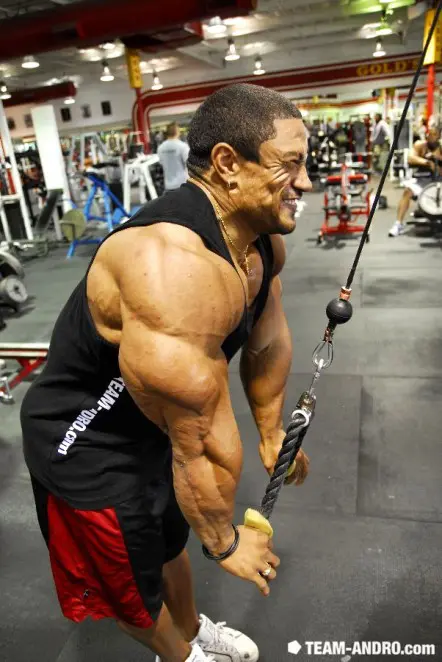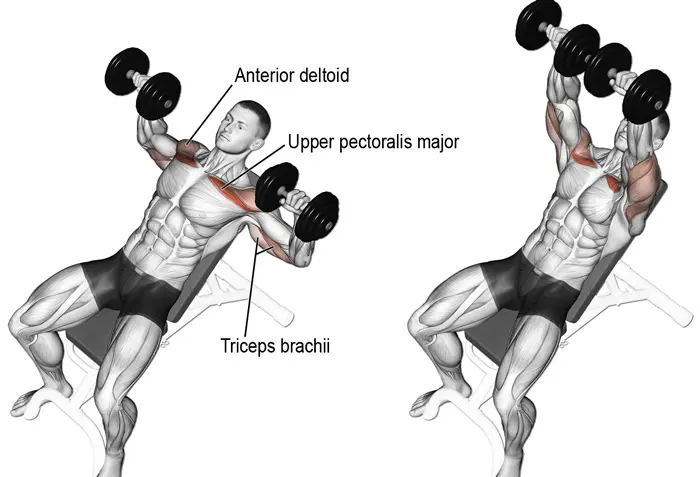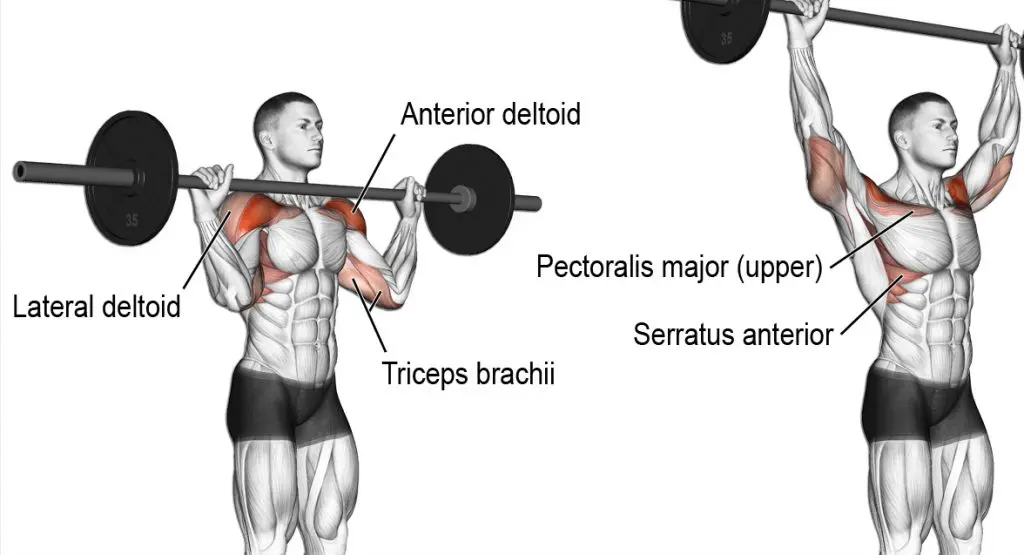The push-pull routine is an ideal workout plan for many who are looking to progress in their fitness journey.
There are a few benefits to training this way from increased recovery time between sessions (depending on how you structure your training), more focus on the major muscles, and even more frequent stimulation for each muscle group.
Full-body, upper-lower, and body part split-style training may be the more popular methods for today’s fitness crowd but push-pull is still a viable option for maximizing your gains.
And you probably guessed just by the name of this split that the routine is structured so that one day you’ll train pulling muscles (back, biceps, hamstrings) and the next day you train push muscles (chest, triceps, shoulders, and quads).
Legs can be split up between both days or you can work them separately because it can be taxing to train more than two muscle groups in one session for some people. Also, there are a few different ways to put together a push-pull workout which we’ve detailed below…
Best Way To Maximize a Push-Pull Routine
Right off the bat, we can tell you that compound exercises will need to be staples in your push-pull routine (they should always be). This is not only better for your overall development but it’s very efficient to work several muscles in one movement.
Level Up Your Fitness: Join our 💪 strong community in Fitness Volt Newsletter. Get daily inspiration, expert-backed workouts, nutrition tips, the latest in strength sports, and the support you need to reach your goals. Subscribe for free!
So, exercises like the squat, deadlift, bench press, row, pull-up, overhead press, and any variations should be included every week.
It’s also ideal to train the large muscle groups (e.g. chest, back) before the smaller muscle groups (e.g. triceps, biceps, etc). The reason being is the major muscles require maximal strength and effort for growth stimulus while the secondary muscles will get worked from assisting in the big lifts.
For small muscle groups and isolation in general, it’s best to add one exercise for each muscle after getting the major muscle groups out of the way to not overdo it if you follow the typical push-pull routine. For example, on your pulling day, the barbell curl is a great exercise after your back training. Then for triceps, a pushdown or dip is sufficient.

Then, of course, you can add in anything else if your workout permits or on your ‘off’ days (from the main split).
Or you can train your major push and pull muscles on one day and designate a day for other muscle groups like triceps and biceps (but we’ll show you how that’s possible shortly).
For optimal recovery, you can plan to allow for at least two days before you train a muscle again which is ideal for recovery if you’re training with good intensity. And you can also vary your volume to where you’ll train even less frequently but still twice per week.
But experience is really the determining factor for the ideal post-recovery period.
If you’re more advanced, you can alternate push-pull days to where you’re training each muscle every other day. However, your training volume (total sets/reps) will need to be cut down significantly to where you’re doing one compound exercise per muscle group per workout.
And again, you’ll need to know your body and what’s enough volume for you, without overtraining.
But typically the more experienced you are in training, the more total volume you can do. Research shows that hypertrophy follows a dose-response relationship which means the more sets/reps in a given period is optimal for maximum growth potential. (1)
But, of course, there is a point of diminishing returns which again, is dependant on the individual.
Here’s an example…
- Monday: Chest, triceps, shoulders, and quads
- Tuesday: Back, biceps, and hamstrings
- Wednesday: Chest, triceps, shoulders, and quads
- Thursday: Back, biceps, and hamstrings
- Friday: Chest, triceps, shoulders, and quads
- Saturday: Back, biceps, and hamstrings
- Sunday: Rest

Where resistance loads are concerned, you’ll train how you normally would. Some days should focus on low reps, heavy weight (6-8 reps), while others should be more moderate (10-20 reps).
5 Push-Pull Routine Options
Option 1
- Day 1: Chest, triceps, shoulders, and quads
- Day 2: Back, biceps, forearms, and hamstrings
- Day 3: Abs and calves
- Day 4: Rest
Repeat
Option 2
- Day 1: Chest, triceps, shoulders, and quads
- Day 2: Rest
- Day 3: Back, biceps, forearms, and hamstrings
- Day 4: Legs
- Day 5: Repeat
Include core work as needed.
Option 3
- Day 1: Chest, triceps, shoulders, and quads
- Day 2: Legs
- Day 3: Back, biceps, forearms, and hamstrings
- Day 4: Rest
Repeat
Include core work as needed.
Option 4
- Day 1: Chest and back
- Day 2: Rest
- Day 3: Legs
- Day 4: Arms
Repeat
Include core work as needed.
Option 5
Your training volume will have to be very low for this routine.
- Day 1: Chest, triceps, shoulders, and quads
- Day 2: Back, biceps, and hamstrings
- Day 3: Chest, triceps, shoulders, and quads
- Day 4: Back, biceps, and hamstrings
- Day 5: Rest
- Day 6: Chest, triceps, shoulders, and quads
- Day 7: Back, biceps, and hamstrings
Repeat
Include core work as needed.
As you can see, there are many ways to do this thing!
Level Up Your Fitness: Join our 💪 strong community in Fitness Volt Newsletter. Get daily inspiration, expert-backed workouts, nutrition tips, the latest in strength sports, and the support you need to reach your goals. Subscribe for free!
Example Push-Pull Workout
Day 1: Chest
Barbell bench press – 3 sets x 8-10 reps

Grip the bar wider than shoulder-width so that your arms are at a 45-degree angle to your torso and use it to position your body into place. Retract your shoulders blades, flex your lats, and arch your back slightly. Unrack the barbell while keeping your lats tight, and bring it down to your lower chest. Press the bar until your arms are extended while contracting your chest muscles.
Keep your shoulders blades retracted. Repeat.
Incline dumbbell press – 2 sets x 10 reps

In the starting position with both dumbbells placed on the end of your quads, use your upper legs to kick the dumbbells back one at a time as you lie back on the bench. Then in the lying down position, move your elbows slightly inward toward your torso at a 45-degree angle. Retract your shoulder blades, keep your lats tight and press the weight up while bringing your hands toward each other to get a good contraction in your chest muscles.
Lower the weight until you feel a slight stretch in your pecs and repeat.
Low-to-high cable fly – 2 sets x 10-12 reps
Attach two single grip handles to a low point in the cable machine. Grip each handle and stand in the center but take a few small steps forward to keep tension on your pecs. Bend your elbows slightly, retract your shoulders blades, and flex your lats. Pull the cables toward the midline of your body to the level of your lower chest while really squeezing your pecs.
Reverse the motion until you feel a slight stretch in your chest muscles and repeat.
Shoulders
Standing overhead/military press – 3 sets x 10-12 reps

With the barbell setup in a rack at about chest level, walk into it and grip the bar slightly outside of shoulder-width. Dip down below the bar, then unrack it and walk backward keeping your head forward. Move your head slightly back so the bar can pass your chin. Flex your glutes, keep your chest up, then press the bar overhead while moving your head forward as the bar reaches overhead.
Then lower the bar back down while moving your head slightly back.
Dumbbell lateral raise – 2 sets x 12 reps
While standing or seated, raise the dumbbells up and out to your sides just above shoulder-level, keeping your thumbs higher than your pinkies with arms fully extended or by maintaining a slight bend in your elbows.
- Seated bent-over lateral raise – 2 sets x 10-12 reps
See link for exercise details.
- Cable rope pushdown – 2 sets x 12 reps
See link for exercise details.
- Dumbbell kickback – 2 sets x 12 reps
While holding a light to medium dumbbell in one hand, bend over keeping your back straight and place one foot in front of the other. Raise the same elbow of the hand holding the dumbbell up and back behind your body so that it’s just higher than your torso. Extend your elbow by flexing your tricep so that your arm is extended behind your body and arm is parallel to the floor.
- EZ bar skull crusher – 2 sets x 12 reps
Grip the EZ bar about shoulder-width and hold it directly above your chin with arms extended while lying on the flat bench. Bend your elbows to lower to the bar to your forward or slightly behind it while keeping your upper arms stationary. Flex your triceps to extend your elbows to where the bar is back in the starting position.
Face pull – 3 sets x 15 to finish off
Day 2: Legs
Quads, hamstrings, and glutes
- Front or back squat – 3 sets x 15 reps
- Lunges – 2 sets x 12 reps
Holding a dumbbell in each hand, move one leg in front of your body far enough to where your shins remain vertical and bend your leg at a 90-degree angle. Then, push upward through your heel back into a standing position and repeat with the opposite leg.
- Bulgarian split squat – 3 sets x 12-15 reps
See link for exercise details.
Calves
- Leg press calf raise – 3 sets x 20 reps
Place the top (ball of your foot) part of your feet on the bottom of the leg press machine so that your heels are hanging off and your legs are slightly bent. Flex your calves by pressing your toes into the platform and then bend your toes backward until you feel a slight stretch in your calves. Repeat.
- Seated calf raise – 2 sets x 12-15 reps
See link for exercise details.
Day 3: Back
- Barbell deadlift 2-3 sets x 10 reps (go to failure or just short)
- Pull-up – 3 sets to failure
Grip the bar wider than shoulder-width and keep your legs extended slightly in front of your body. Retract and depress your shoulder blades, then pull yourself up to the bar while squeezing your back muscles. Lower your body back down, keeping your shoulders depressed, so don’t allow your shoulders to move up toward your ears.
- Cable shrug – 3 sets x 12 reps
Attach a single-grip handle to a low point on the cable machine then grip it with either hand while facing laterally to the cable pulley. Retract your shoulder blades and perform the shrug by lifting your shoulder up and back toward your ear. Perform the reps nice and controlled to feel the muscle working.
Biceps
- Barbell curl – 2 sets x 8 reps (failure) into drag curl with same weight (failure)
Grip the barbell slightly wider than shoulder-width standing erect. Curl the weight upward while moving your upper arms only slightly forward contracting your biceps as much as you can. Slowly lower the barbell back down but don’t lock out your elbows.
- Chin-up – 2 sets x failure
Grip the bar with your palms facing you, so your hands are shoulder-width distance apart from each other. Pull yourself up using your biceps and get a good contraction at the top.
- Reverse curl – 2 sets x 12-15 reps
Grip the barbell with palms facing away from you at about shoulder-width. Curl the bar to the top and slowly lower it back down.
Forearms
- Wrist curl – 3 sets x 20 reps
While standing, grip a barbell or dumbbell deep in your hand and curl your wrist inward toward your body or behind your body squeezing your forearm muscles. Straighten your wrist but keep the grip deep in your hand and not on your fingers. Repeat.
- Day 4: Rest
- Day 5: Repeat day 1 workout
- Day 6: Repeat day 2 workout
- Day 7: Repeat day 3 workout
- Day 8: Rest
Wrapping Up
Implementing a push-pull workout routine is a good idea for many reasons whether your progress has stalled or maybe you’re just looking for something different to try for a change.
It’s a great way to train your muscles several times a week and still recover or you can opt for more frequent sessions which means you’ll need to adjust your training volume.
But either way, push-pull is effective.








